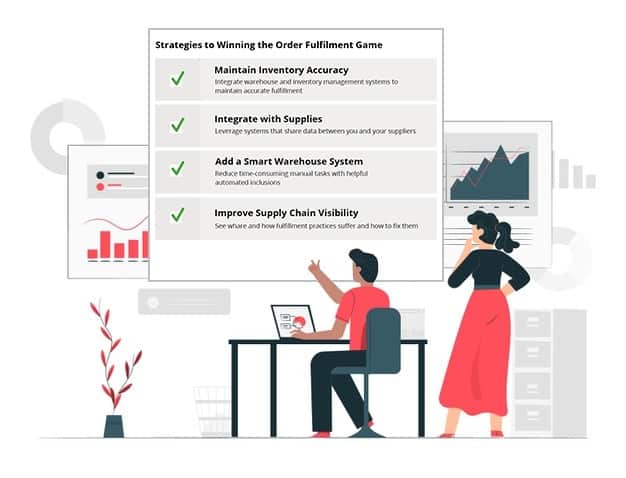Even if businesses are geared towards different markets, the challenges they face in procurement management and order fulfillment are the same.
The recent pandemic has made the process trickier, but every challenge also is an opportunity to find solutions that should be meeting accuracy and demands for quicker delivery.
In this post, let’s take a closer look at what industry experts recognize as the top three challenges in order procurement and order fulfillment, along with the opportunities they create.
Top 3 challenges facing purchasing and supply management
Businesses in manufacturing, retail, and tech, agree that heightened customer demands and narrowing order processing windows have increased complexity and internal costs. The intensity may vary between industry sectors, but procurement departments and order fulfillment functions across the board are unanimous on these challenges.
 1. Poor visibility in the supply chain
1. Poor visibility in the supply chain
Almost 60% of order procurement professionals have identified that lack of visibility between the finance department, procurement functions, and suppliers (significantly beyond tier-one suppliers) slows their decision-making process and, in turn, loses them a competitive market edge.
Supply chain transparency is also part of the quality and ethical obligation. Maintaining integrity and customer confidence requires companies to answer to “where is the stuff coming from?”
The opportunity: Companies should decide on practical tools and the levels of transparency they need to implement.
Controlling corporate spending requires teams involved to harness data in real-time. When procurement management systems are not linked, then most of the purchase process will continue to have a high manual occurrence through spreadsheets. That always ends in data accuracy falling by the wayside. Transactions through a centralized system make it easier to track unwanted spending and ensure compliance with the company’s purchasing policy.
2. Inventory management and demand forecasting
It is not just how quickly but how accurately supply can meet demand. Nothing explains this better than a food analogy.
The customer walks into a restaurant and picks a dish from a menu. The demand is what he (or she) orders and the supply is how quickly the kitchen can get the food to the hungry customer. The waiter and the chef are involved with fulfilling the order, but they are busy taking orders and cooking and serving a continuously incoming list of orders. These folks are on the frontline, so who is ensuring that enough ingredients are available, whatever be the demand?
Customers expect you to always have everything on the menu. Balancing the inflow and outflow with no wastage requires an inventory management system that keeps a lean but effective inventory.
So there you have it, the heart of manufacturing, construction, or retail is inventory. And this inventory might have to be managed from different locations, warehouses, or even drop-shippers. Ensuring a high-fill rate without investing too much in stock-piled inventory requires arriving at the right safety-stock quantity using statistical methods. Just as you should never grocery shop on an empty stomach, never order stock that you might not need.
The opportunity: A Ware House Management System (WMS), when linked with barcode technology, can get your real-time business data of each SKU to monitor inventory levels.
Large organizations also integrate statistical methods to measure demand/spikes (rather than using averages) for demand forecasting. This methodology has seen an inventory reduction, on average by 25% and many times even higher.
Smaller companies might not have enough data points to provide accurate statistical results. There is another method, Demand-Driven MRP (Demand Driven Materials Requirement Planning). While it might not have the same high accuracy level, it still provides a useful inventory control mechanism by dynamically controlling stock levels based on demand.
Having software that will reorder predictively is critical to leaner order fulfillment.
3. Order fulfillment and the human factor
Picture this!
You are a small business with about 20 orders a day.
You hire a data entry person in your order fulfillment team to copy-paste the information between different applications. Sometimes all it takes is downloading and then uploading a CSV file. Other times it is keying the details over and over again. This is a repetitive set of actions starting at the order, through invoice creation, and on to delivery.
What happens when there are over 1000 orders?
You will need a team of data entry personnel to work full time on such repetitive tasks (human error aside). Why do that when technology can automate the process much more efficiently?
Yet, nearly half of small and midsize businesses still use manual methods.
It seems evident that the single most effective way to improve order fulfillment is by automating data as it moves between different applications. The problems don’t stop there, though.
Businesses purchase applications but then realize that getting them to communicate with other applications is difficult because they were not designed that way. The good news is that there are companies that can help you with complex data integration.
The opportunity: Automation might be the right way to improve order fulfillment, but purchasing an order management system is not enough. Automation is a necessity, but the opportunity lies with the human side of the equation.
You can’t just wave a magic wand and get your team to use software. Getting internal compliance will need patience. The pandemic has made the acceptance of technology to manage data more acceptable by even the naysayers. This is an opportunity to talk to everyone involved and get them on board.
In conclusion
If your company is held back by challenges facing purchasing and supply management, the solution might be to break the issues down and address your demand and supply variables. Traditional order management ERP systems might not be able to support your business needs.
SMBs are leaning towards innovative technology solutions to improve their order fulfillment and procurement management systems.
Are you interested in discovering the full potential of the iTech Data Services GDPR compliant data integration platform? Lets Talk


 1. Poor visibility in the supply chain
1. Poor visibility in the supply chain



